Chenxu Wang
Learning Compact Representations of LLM Abilities via Item Response Theory
Oct 01, 2025Abstract:Recent years have witnessed a surge in the number of large language models (LLMs), yet efficiently managing and utilizing these vast resources remains a significant challenge. In this work, we explore how to learn compact representations of LLM abilities that can facilitate downstream tasks, such as model routing and performance prediction on new benchmarks. We frame this problem as estimating the probability that a given model will correctly answer a specific query. Inspired by the item response theory (IRT) in psychometrics, we model this probability as a function of three key factors: (i) the model's multi-skill ability vector, (2) the query's discrimination vector that separates models of differing skills, and (3) the query's difficulty scalar. To learn these parameters jointly, we introduce a Mixture-of-Experts (MoE) network that couples model- and query-level embeddings. Extensive experiments demonstrate that our approach leads to state-of-the-art performance in both model routing and benchmark accuracy prediction. Moreover, analysis validates that the learned parameters encode meaningful, interpretable information about model capabilities and query characteristics.
CollabVLA: Self-Reflective Vision-Language-Action Model Dreaming Together with Human
Sep 18, 2025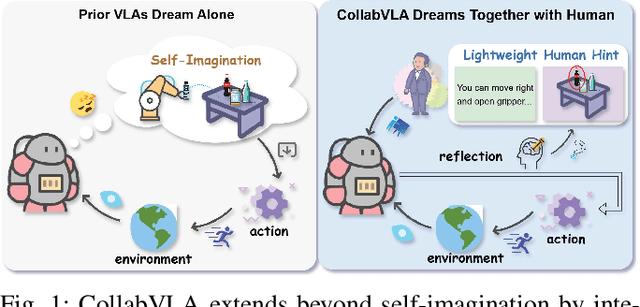



Abstract:In this work, we present CollabVLA, a self-reflective vision-language-action framework that transforms a standard visuomotor policy into a collaborative assistant. CollabVLA tackles key limitations of prior VLAs, including domain overfitting, non-interpretable reasoning, and the high latency of auxiliary generative models, by integrating VLM-based reflective reasoning with diffusion-based action generation under a mixture-of-experts design. Through a two-stage training recipe of action grounding and reflection tuning, it supports explicit self-reflection and proactively solicits human guidance when confronted with uncertainty or repeated failure. It cuts normalized Time by ~2x and Dream counts by ~4x vs. generative agents, achieving higher success rates, improved interpretability, and balanced low latency compared with existing methods. This work takes a pioneering step toward shifting VLAs from opaque controllers to genuinely assistive agents capable of reasoning, acting, and collaborating with humans.
PerPilot: Personalizing VLM-based Mobile Agents via Memory and Exploration
Aug 25, 2025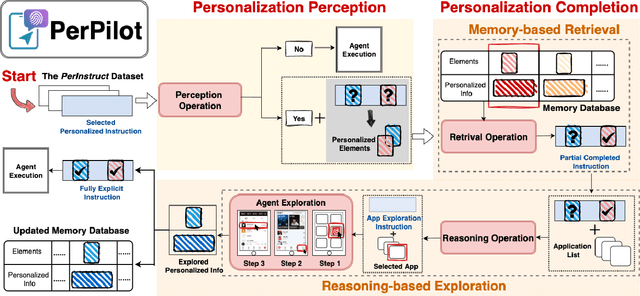


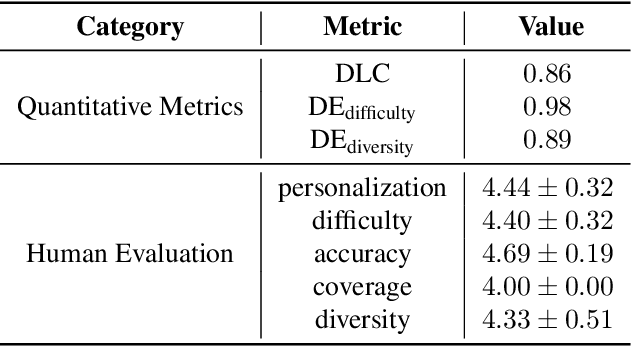
Abstract:Vision language model (VLM)-based mobile agents show great potential for assisting users in performing instruction-driven tasks. However, these agents typically struggle with personalized instructions -- those containing ambiguous, user-specific context -- a challenge that has been largely overlooked in previous research. In this paper, we define personalized instructions and introduce PerInstruct, a novel human-annotated dataset covering diverse personalized instructions across various mobile scenarios. Furthermore, given the limited personalization capabilities of existing mobile agents, we propose PerPilot, a plug-and-play framework powered by large language models (LLMs) that enables mobile agents to autonomously perceive, understand, and execute personalized user instructions. PerPilot identifies personalized elements and autonomously completes instructions via two complementary approaches: memory-based retrieval and reasoning-based exploration. Experimental results demonstrate that PerPilot effectively handles personalized tasks with minimal user intervention and progressively improves its performance with continued use, underscoring the importance of personalization-aware reasoning for next-generation mobile agents. The dataset and code are available at: https://github.com/xinwang-nwpu/PerPilot
Continual Gradient Low-Rank Projection Fine-Tuning for LLMs
Jul 03, 2025
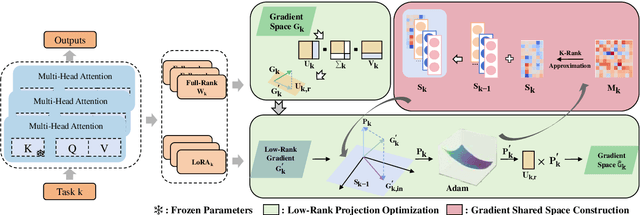

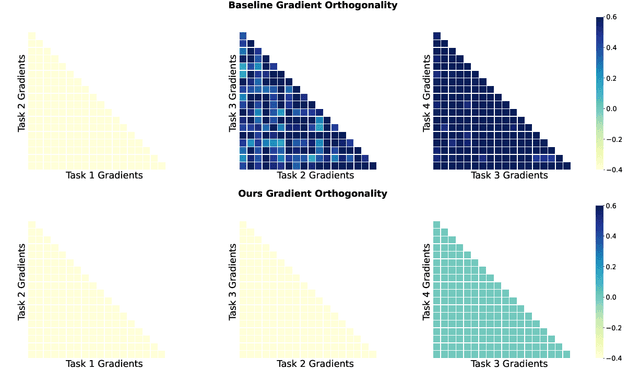
Abstract:Continual fine-tuning of Large Language Models (LLMs) is hampered by the trade-off between efficiency and expressiveness. Low-Rank Adaptation (LoRA) offers efficiency but constrains the model's ability to learn new tasks and transfer knowledge due to its low-rank nature and reliance on explicit parameter constraints. We propose GORP (Gradient LOw Rank Projection) for Continual Learning, a novel training strategy that overcomes these limitations by synergistically combining full and low-rank parameters and jointly updating within a unified low-rank gradient subspace. GORP expands the optimization space while preserving efficiency and mitigating catastrophic forgetting. Extensive experiments on continual learning benchmarks demonstrate GORP's superior performance compared to existing state-of-the-art approaches. Code is available at https://github.com/Wcxwcxw/GORP.
The Avengers: A Simple Recipe for Uniting Smaller Language Models to Challenge Proprietary Giants
May 26, 2025Abstract:As proprietary giants increasingly dominate the race for ever-larger language models, a pressing question arises for the open-source community: can smaller models remain competitive across a broad range of tasks? In this paper, we present the Avengers--a simple recipe that effectively leverages the collective intelligence of open-source, smaller language models. Our framework is built upon four lightweight operations: (i) embedding: encode queries using a text embedding model; (ii) clustering: group queries based on their semantic similarity; (iii) scoring: scores each model's performance within each cluster; and (iv) voting: improve outputs via repeated sampling and voting. At inference time, each query is embedded and assigned to its nearest cluster. The top-performing model(s) within that cluster are selected to generate the response using the Self-Consistency or its multi-model variant. Remarkably, with 10 open-source models (~7B parameters each), the Avengers collectively outperforms GPT-4.1 on 10 out of 15 datasets (spanning mathematics, code, logic, knowledge, and affective tasks). In particular, it surpasses GPT-4.1 on mathematics tasks by 18.21% and on code tasks by 7.46%. Furthermore, the Avengers delivers superior out-of-distribution generalization, and remains robust across various embedding models, clustering algorithms, ensemble strategies, and values of its sole parameter--the number of clusters. We have open-sourced the code on GitHub: https://github.com/ZhangYiqun018/Avengers
A Simple Detector with Frame Dynamics is a Strong Tracker
May 08, 2025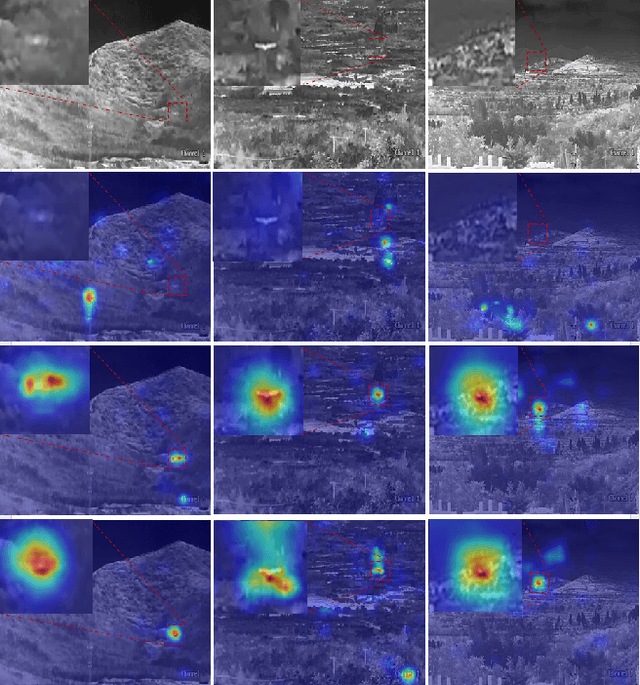
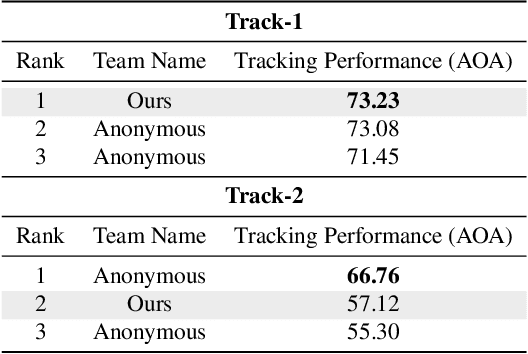


Abstract:Infrared object tracking plays a crucial role in Anti-Unmanned Aerial Vehicle (Anti-UAV) applications. Existing trackers often depend on cropped template regions and have limited motion modeling capabilities, which pose challenges when dealing with tiny targets. To address this, we propose a simple yet effective infrared tiny-object tracker that enhances tracking performance by integrating global detection and motion-aware learning with temporal priors. Our method is based on object detection and achieves significant improvements through two key innovations. First, we introduce frame dynamics, leveraging frame difference and optical flow to encode both prior target features and motion characteristics at the input level, enabling the model to better distinguish the target from background clutter. Second, we propose a trajectory constraint filtering strategy in the post-processing stage, utilizing spatio-temporal priors to suppress false positives and enhance tracking robustness. Extensive experiments show that our method consistently outperforms existing approaches across multiple metrics in challenging infrared UAV tracking scenarios. Notably, we achieve state-of-the-art performance in the 4th Anti-UAV Challenge, securing 1st place in Track 1 and 2nd place in Track 2.
Trajectory Entropy Reinforcement Learning for Predictable and Robust Control
May 07, 2025Abstract:Simplicity is a critical inductive bias for designing data-driven controllers, especially when robustness is important. Despite the impressive results of deep reinforcement learning in complex control tasks, it is prone to capturing intricate and spurious correlations between observations and actions, leading to failure under slight perturbations to the environment. To tackle this problem, in this work we introduce a novel inductive bias towards simple policies in reinforcement learning. The simplicity inductive bias is introduced by minimizing the entropy of entire action trajectories, corresponding to the number of bits required to describe information in action trajectories after the agent observes state trajectories. Our reinforcement learning agent, Trajectory Entropy Reinforcement Learning, is optimized to minimize the trajectory entropy while maximizing rewards. We show that the trajectory entropy can be effectively estimated by learning a variational parameterized action prediction model, and use the prediction model to construct an information-regularized reward function. Furthermore, we construct a practical algorithm that enables the joint optimization of models, including the policy and the prediction model. Experimental evaluations on several high-dimensional locomotion tasks show that our learned policies produce more cyclical and consistent action trajectories, and achieve superior performance, and robustness to noise and dynamic changes than the state-of-the-art.
Multi-Modal Hypergraph Enhanced LLM Learning for Recommendation
Apr 13, 2025



Abstract:The burgeoning presence of Large Language Models (LLM) is propelling the development of personalized recommender systems. Most existing LLM-based methods fail to sufficiently explore the multi-view graph structure correlations inherent in recommendation scenarios. To this end, we propose a novel framework, Hypergraph Enhanced LLM Learning for multimodal Recommendation (HeLLM), designed to equip LLMs with the capability to capture intricate higher-order semantic correlations by fusing graph-level contextual signals with sequence-level behavioral patterns. In the recommender pre-training phase, we design a user hypergraph to uncover shared interest preferences among users and an item hypergraph to capture correlations within multimodal similarities among items. The hypergraph convolution and synergistic contrastive learning mechanism are introduced to enhance the distinguishability of learned representations. In the LLM fine-tuning phase, we inject the learned graph-structured embeddings directly into the LLM's architecture and integrate sequential features capturing each user's chronological behavior. This process enables hypergraphs to leverage graph-structured information as global context, enhancing the LLM's ability to perceive complex relational patterns and integrate multimodal information, while also modeling local temporal dynamics. Extensive experiments demonstrate the superiority of our proposed method over state-of-the-art baselines, confirming the advantages of fusing hypergraph-based context with sequential user behavior in LLMs for recommendation.
Thought-Path Contrastive Learning via Premise-Oriented Data Augmentation for Logical Reading Comprehension
Sep 24, 2024



Abstract:Logical reading comprehension is a challenging task that entails grasping the underlying semantics of text and applying reasoning to deduce the correct answer. Prior researches have primarily focused on enhancing logical reasoning capabilities through Chain-of-Thought (CoT) or data augmentation. However, previous work constructing chain-of-thought rationales concentrates solely on analyzing correct options, neglecting the incorrect alternatives. Addtionally, earlier efforts on data augmentation by altering contexts rely on rule-based methods, which result in generated contexts that lack diversity and coherence. To address these issues, we propose a Premise-Oriented Data Augmentation (PODA) framework. This framework can generate CoT rationales including analyses for both correct and incorrect options, while constructing diverse and high-quality counterfactual contexts from incorrect candidate options. We integrate summarizing premises and identifying premises for each option into rationales. Subsequently, we employ multi-step prompts with identified premises to construct counterfactual context. To facilitate the model's capabilities to better differentiate the reasoning process associated with each option, we introduce a novel thought-path contrastive learning method that compares reasoning paths between the original and counterfactual samples. Experimental results on three representative LLMs demonstrate that our method can improve the baselines substantially across two challenging logical reasoning benchmarks (ReClor and LogiQA 2.0). The data and code are released at https://github.com/lalalamdbf/TPReasoner.
Multi-clue Consistency Learning to Bridge Gaps Between General and Oriented Object in Semi-supervised Detection
Jul 08, 2024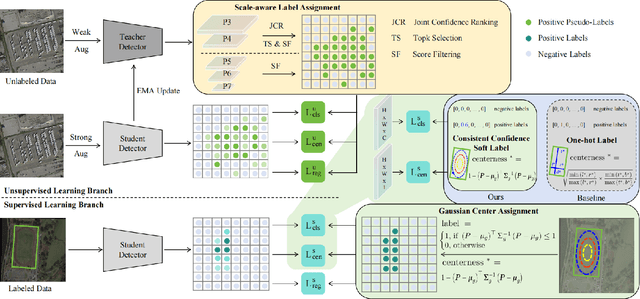
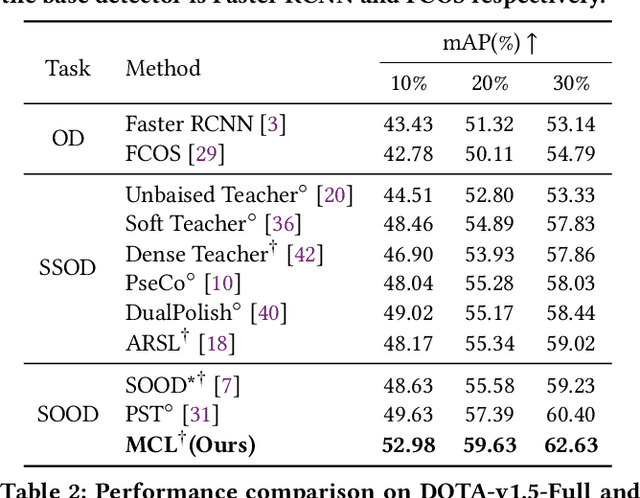
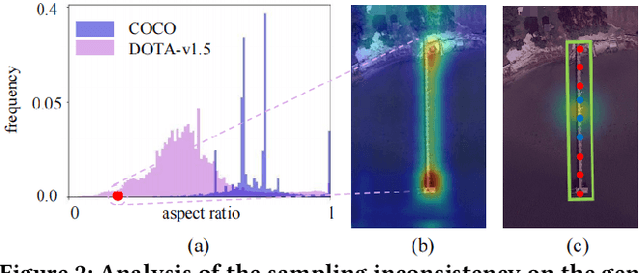
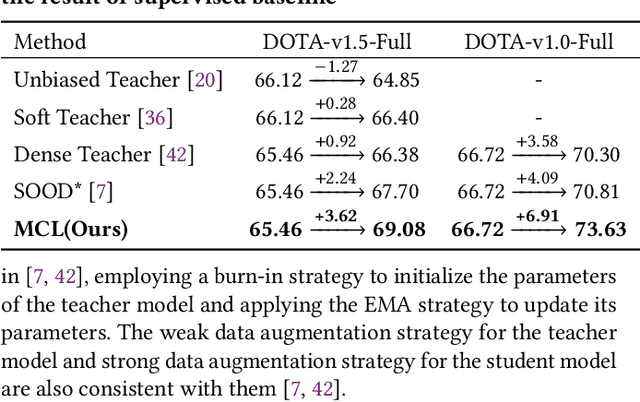
Abstract:While existing semi-supervised object detection (SSOD) methods perform well in general scenes, they encounter challenges in handling oriented objects in aerial images. We experimentally find three gaps between general and oriented object detection in semi-supervised learning: 1) Sampling inconsistency: the common center sampling is not suitable for oriented objects with larger aspect ratios when selecting positive labels from labeled data. 2) Assignment inconsistency: balancing the precision and localization quality of oriented pseudo-boxes poses greater challenges which introduces more noise when selecting positive labels from unlabeled data. 3) Confidence inconsistency: there exists more mismatch between the predicted classification and localization qualities when considering oriented objects, affecting the selection of pseudo-labels. Therefore, we propose a Multi-clue Consistency Learning (MCL) framework to bridge gaps between general and oriented objects in semi-supervised detection. Specifically, considering various shapes of rotated objects, the Gaussian Center Assignment is specially designed to select the pixel-level positive labels from labeled data. We then introduce the Scale-aware Label Assignment to select pixel-level pseudo-labels instead of unreliable pseudo-boxes, which is a divide-and-rule strategy suited for objects with various scales. The Consistent Confidence Soft Label is adopted to further boost the detector by maintaining the alignment of the predicted results. Comprehensive experiments on DOTA-v1.5 and DOTA-v1.0 benchmarks demonstrate that our proposed MCL can achieve state-of-the-art performance in the semi-supervised oriented object detection task.
 Add to Chrome
Add to Chrome Add to Firefox
Add to Firefox Add to Edge
Add to Edge